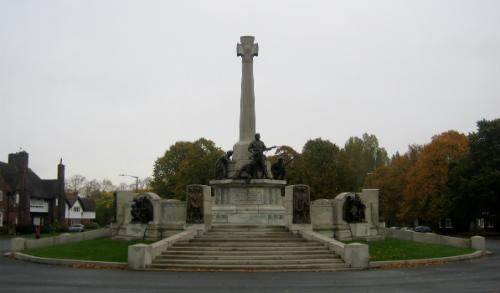A view from the Lady Lever's South End

If you stand looking out of the south doors of the Lady Lever Art Gallery you take in a stunning vista from the nearby fountain, through the rose gardens, towards the Port Sunlight War Memorial.
Originally these doors are where you would have entered the gallery. While they are no longer used in this way, as part of the South End redevelopment in 2016 a new pair of glass doors was installed to restore this view. Visitors can now gaze out upon Port Sunlight village, helping those within the Lady Lever Art Gallery to connect with the beautiful surroundings.
Even from this distance the war memorial naturally draws the eye due to its impressive size, but closer inspection reveals something rather unusual. If you take a look at the bronze figures on the memorial you will see that they are not all armed forces, they’re not even all men, there are women and children represented as well.

Bronze figures of a mother and children on the Port Sunlight War Memorial
Commissioned by Port Sunlight’s founder, William Hesketh Lever and beautifully restored by the Port Sunlight Village Trust, the memorial is the work of William Goscombe John, who had previously produced the effigy for Lady Lever’s tomb.
Lever wanted the memorial’s theme to be ‘Defence of the Realm’ and on it amongst the soldiers we can see a nurse, a boy scout, and a mother comforting her children. It is not just the fighting men who are represented here, but all those who supported them and suffered the horror and anxieties of war.
The inclusion of women and children on the memorial earned the sculptor heavy criticism at the time, today however it is arguably these figures that give it such obvious power. In particular the expressions of the mother and her children speak eloquently, without need for words, of the sufferings of those left at home.

This grouping of children on the memorial is modelled on Lever’s grandchildren. The boy to the left (Philip) would grow up to become the third and final Lord Leverhulme. Philip maintained the family connection with the Lady Lever Art Gallery throughout his life.
The memorial has an inclusive feel to it that seems typical of Lever and his philosophy. In 1921 it was unveiled, not by a local dignitary, but by two Lever Brothers ex-servicemen, Sergeant Eames from Port Sunlight, blinded at the battle of the Somme, and Private Robert Cruickshank from the London Branch Office, awarded the Victoria Cross.
The names on the memorial include all those working for Lever Brothers around the world who lost their lives in the First World War. Originally Lever wished to include the names (more than 4,000 in all) of all the employees who had served but this was simply not practical. Instead the names were all listed in a book buried beneath the memorial with copies placed in the nearby Christ Church and in the Lady Lever Art Gallery.
The Lady Lever’s copy is stored carefully in the archives today but visitors can ask to see a reproduction at the information desk. Listed within are the serving men but also women’s auxiliaries and even six civilian prisoners.
The original plaster models for the memorials bronze figures are also within the Lady Lever’s beautiful collections, though not currently on display. At the original opening of the gallery in 1922 Lever said:
"Art can be to everyone an inspiration. It is within the reach of all of us".
It is this same inclusive attitude that can be seen in the war memorial, with its women and children standing alongside the soldiers, and it is this same attitude that we worked hard to promote in the South End redevelopment in 2016, driven by Lever’s original vision of a space where everyone can come to be inspired.
When you next visit the Lady Lever Art Gallery don’t forget to take in the view from the south doors, donated by Patron and Centenary Club member Andrew Collinge, and if you have time I’d highly recommend a wander up through the rose gardens to visit the war memorial.
